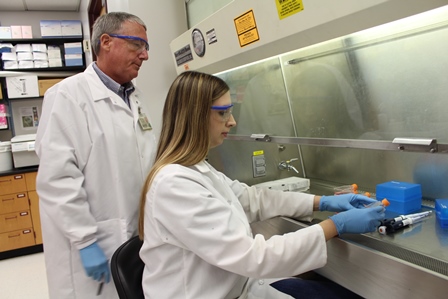
By Sarah Carey
A new organism identified by University of Florida researchers could indicate that seals are a potential source for human exposure to the bacteria and could cause more severe disease than previously thought.
The organism, discovered by UF researchers with expertise in mycoplasma bacteria, was identified in tissue samples taken from the hips of a hunter who became deathly ill days after returning home from a subsistence seal hunt. Among his symptoms: high fever, a swollen right middle finger and acute pain in both hips.
In an article that appeared last fall in Clinical Infectious Diseases, the scientists reported that due to the known association between mycoplasma species with “seal finger,” an infection normally restricted to the fingers and hand, the likely cause of the man’s illness was a systemic spread of infection from the middle finger to the hips.
The findings describe what is believed to be the first known case of disseminated seal finger mycoplasmosis, said Dr. Daniel R. Brown, an associate professor of infectious diseases at the UF College of Veterinary Medicine.
“Although we weren’t able to get samples from the finger, the most likely explanation is that the infection traveled from the hunter’s hand to his hips,” Brown said. “It almost certainly had to happen that way.”
Although seal finger mycoplasmosis was first described more than 100 years ago, the manifestation of the disease in this case was unique, researchers said. Brown and his team became involved soon after tissue samples taken after the hunter was admitted to a hospital in Alaska were sent to the University of Washington, where based on general tests, scientists began to suspect mycoplasma infection.
The findings led the hunter’s medical team to delve deeper into their patient’s history, whereupon they learned that one week prior to the onset of symptoms, the hunter had harvested three ringed seals without wearing protective gloves. Additionally, physicians learned that the man had been treated for pain and swelling of a finger after butchering a walrus.
The hunter’s physicians then contacted the Centers for Disease Control and Prevention, where staff aware of UF’s expertise in mycoplasma research and diagnostics put the hunter’s medical group in touch with Brown. Brown’s research team subsequently determined through DNA sequencing of tissue and hip joint fluid samples that the particular strain of mycoplasma they were seeing was unique and resembled strains previously seen in elephants and raccoons, as well as in domestic cats, but never before in seals.
“We’ve known that people can get ‘seal finger’ disease in their hands from hunting seals, but this situation was different as it went systemic and ended up in the hunter’s joints,” Brown said. “Its presumed spread from the patient’s finger to his hips is remarkable because such dissemination is unprecedented in prior reports of seal finger zoonotic mycoplasmal infection of the hand.”
The UF College of Veterinary Medicine houses the world’s largest collection of mycoplasma specimens. Researchers around the globe work through the Brown laboratory to access these samples to study the microbes in hopes of seeking potential remedies for diseases that affect plants, animals and humans.

